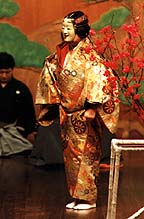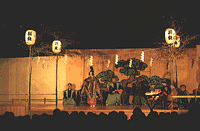-
ACTOR
-
There are two types of actors-the principal actor is called the SHITE (usually masked) and the secondary character, the WAKI.
-
COSTUME
-
Multiple layers of stiff brocades, serve both to create a sense of elegance and to make the actors appear larger than life.
|

|
 |
-
MASK
-
The actors' faces are either masked or completely expressionless, so that the characters seem like dream figures moving imperceptibly through a world beyond reality.
|
-
MOVEMENT
- NOH actor moves in such a way to suggest the insubstantiality of
his appearance. The transit of the actor to and across the stage
is extremely slow as in order to give only the faintest hint of movement.
-
PLAYS
-
Parts of the script are prose (KOTOBA) but most are poetry (UTAI). The prose is 14th century upper class Japanese; inflected in such a way as to be comprehensible only to the scholar.
- STAGE
- (Click here and you can find details
of the Noh stage.)
|
-
TAKIGI-NOH
-
NOH performed outside by the light of a bonfire.
-
KYOGEN
-
Independent humorous pieces that are traditionally performed between two separate NOH plays as comic relief.
|

TAKIGI-NOH
|





